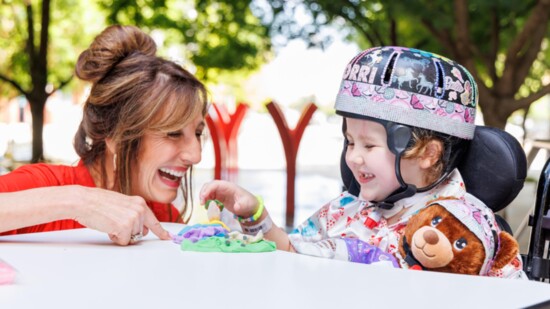More than a decade ago, Valerie Hanks watched over her daughter’s bedside at UAB Medicine, praying for a miracle. Inspired by the doctors, nurses, therapists, and hospital team members who sustained her child’s life after a car accident, Valerie decided, in a pivotal moment, to explore a career where she could make a similar difference.
A native of Louisiana and a lifelong proponent of self-expression, Valerie leaped into the first iteration of her art career as a high school graduate when she decided to attend the Art Institute of Houston’s two-year program. She worked as an art director for creative agencies, then pivoted to a freelance business to raise her kids and give back to causes she valued – which included adopting from international orphanages and helping her new family members thrive. As the mother of three biological children, seven internationally adopted children, and five “bonus children” with her husband, Valerie focused on family until that day at UAB when she decided to return to school in her 50s.
Though she initially considered becoming a nurse – “it wasn’t for me,” she admits – the choice to major in psychology and minor in art studio was well-thought-out once she learned more about UAB Arts in Medicine. A fledgling program at the time, Valerie was enticed by the idea of sharing her art skills in a medical setting – she’d seen firsthand how visual art had lifted her daughter’s spirits as well.
“I did the research on UAB Arts in Medicine while I was an undergrad, and I decided to volunteer with the program,” she says. “Then, Kimberly Kirklin, director of the program, accepted me as an artist in residence. She knew I was in school, and my planned trajectory was to get a Master’s in Art Therapy.”
Valerie completed her Master’s of Art in Art Therapy with an emphasis in Counseling at St. Mary-of-the-Woods College in Indiana, one of the only schools nationwide to offer an American Art Therapy Association-approved hybrid art therapy program. She was studying for her upcoming board certification exam the day we spoke. She explains that board certification isn’t mandatory to practice, but it was her personal goal to complete this highest distinction in the art therapy journey.
“This calling came out of a tragedy – my daughter’s accident,” she muses. “But beautiful things can come out of tragedy, and there’s strength in its aftermath.”
UAB’s Arts in Medicine program, which includes other therapeutic forms of self-expression such as theater, dance, and writing, has received “wings” since the Covid pandemic, at least from Valerie’s perspective. “The pandemic highlighted the need for creative services,” she says. “It’s beautiful to see how creative and expressive arts have been newly valued and appreciated. And we can be a part of the team – the research shows it works, which is exciting.”
With Kimberly Kirklin's and Amy Brown's support, who worked in art therapy already and “passed the baton,” Valerie flourished in her new profession. As a contract employee for the UAB program, she works with patients in pediatric oncology at Children’s of Alabama, adult patients at UAB Hospital, and patients in Palliative and Supportive Care – and more on the way as UAB Arts in Medicine gains traction and forms partnerships.
The opportunity to promote healing through artistic expression is a sacred calling for Valerie. She has witnessed, over and over, how children who struggle to stay well and stay motivated can break into a smile or feel less alone once offered a set of paints or modeling clay. She describes walking into the room of a child around 8 or 10 years old who misses friends and family and is battling medical issues. On those occasions, the creative opportunity can make a world of difference.
“They need their favorite superhero painted on a banner and words of encouragement,” she says. “They can be reminded with positive affirmations of all the amazing things they can still do and be.”
Some children are unable or unwilling to speak, but tactile media helps them make sense of their feelings, she adds. “If they can’t express emotions, they can perhaps sculpt what their anxiety looks like. When you take care of the well-being of a person and give them outlets for their expression, it opens communication. We all have stories. Art cuts through barriers, and I love that.”
When prompted for an example of the power of art, Valerie replies that there are “too many” but soon begins sharing an experience she had with one little girl whose prognosis was terminal. Even as the child’s physical abilities declined, her spirit for creating art with her loved ones stayed strong.
“I hung up a huge cloth canvas. Her extended family and two little brothers would add to it, and she would wheel over in her chair and add to it,” Valerie shares. “Even later, when nurses didn’t know if she would get out of bed again, she opened her eyes, pointed, and her parents knew – she wanted to add to that canvas. She would ask to be taken out of her wheelchair to reach it. It was heartbreaking to know the child’s life was ending . . . but it was an honor to know that a work of art serves as a legacy and a gift.”
Valerie Hanks, Art Therapist
To learn more about UAB Arts in Medicine, visit https://www.uabmedicine.org/specialties/arts-in-medicine
Beautiful things can come out of tragedy, and there’s strength in its aftermath.
They can be reminded with positive affirmations of all the amazing things they can still do and be.
